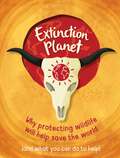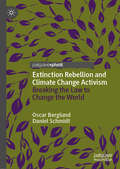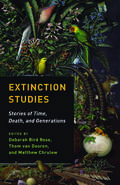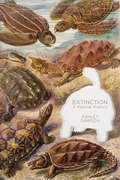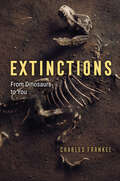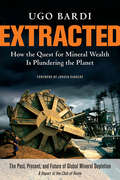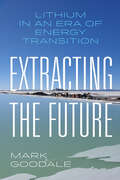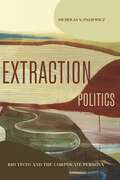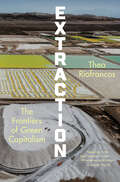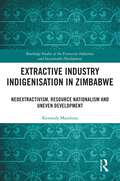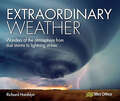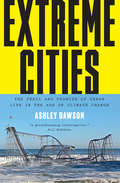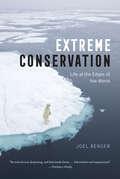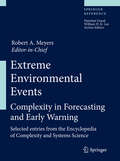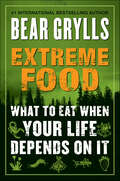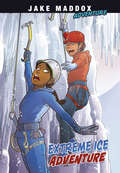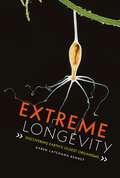- Table View
- List View
Extinction Planet
by Anna ClaybourneExtinction Planet offers young readers a clear, insightful look at Earth's wildlife extinction crisisIt is estimated that out of around eight million species on Earth, at least one million plant and animal species are threatened with extinction, and that the current rate of extinction is up to 100 times higher than in any previous mass extinction. And it's human activity that's largely responsible for this frightening decline.Extinction Planet takes a non-alarmist, but truthful, look at Earth's extinction crisis, explaining what a mass extinction is, how they occur and what their repercussions can be. It explores how, as humankind has caused this latest biodiversity crisis, we also have the solutions to slow or stop its damage, from reining in overconsumption, rewilding natural places, making farming more planet-friendly, preventing overfishing and seriously tackling climate change. It also suggests ways we can all live in a more planet-friendly way, from global changes such as investing in renewable energy sources, to individual actions such as buying sustainable products and eating less meat and fish.Following on from Plastic Planet, Hot Planet, Recycled Planet and Sustainable Planet, Extinction Planet features the same blend of illustrations and photos and a striking cover, and is written by the award-winning author Anna Claybourne.Aimed at readers aged 9 and up.
Extinction Rebellion and Climate Change Activism: Breaking the Law to Change the World
by Daniel Schmidt Oscar BerglundThis book summarises and critiques Extinction Rebellion (XR) as a social movement organisation, engaging with key issues surrounding its analysis, strategy and tactics. The authors suggest that XR have an underdeveloped and apolitical view of the kind of change necessary to address climate change, and that while this enables the building of broad movements, it is also an obstacle to achieving the systemic change that they are aiming for. The book analyses different forms of protest and the role of civil disobedience in their respective success or failure; democratic demands and practices; and activist engagement with the political economy of climate change. It engages with a range of theoretical perspectives that address law-breaking in protest and participatory forms of democracy including liberal political theory; anarchism and forms of historical materialism, and will be of interest to students and scholars across politics, international relations, sociology, policy studies and geography, as well as those interested in climate change politics and activism.
Extinction Studies: Stories of Time, Death, and Generations
by Thom Van Dooren Edited by Deborah Bird Rose Matthew ChrulewExtinction Studies focuses on the entangled ecological and social dimensions of extinction, exploring the ways in which extinction catastrophically interrupts life-giving processes of time, death, and generations. The volume opens up important philosophical questions about our place in, and obligations to, a more-than-human world. Drawing on fieldwork, philosophy, literature, history, and a range of other perspectives, each of the chapters in this book tells a unique extinction story that explores what extinction is, what it means, why it matters—and to whom.
Extinction and Memorial Culture: Reckoning with Species Loss in the Anthropocene
by Hannah StarkThis book considers how we encounter and make meaning from extinction in diverse settings and cultures. It brings together an international and interdisciplinary range of scholars to consider how extinction is memorialised in museums and cultural institutions, through monuments, in literature and art, through public acts of ritual and protest, and in everyday practices. In an era in which species are becoming extinct at an unprecedented rate, we must find new ways to engage critically, creatively, and courageously with species loss. Extinction and Memorial Culture: Reckoning with Species Loss in the Anthropocene develops the conceptual tools to think in complex ways about extinctions and their aftermath, along with providing new insights into commemorating and mourning more-than-human lives. This book will be of great interest to students and scholars of the environmental humanities, extinction studies, memorial culture, and the Anthropocene.
Extinction: A Radical History
by Ashley DawsonSome thousands of years ago, the world was home to an immense variety of large mammals. From wooly mammoths and saber-toothed tigers to giant ground sloths and armadillos the size of automobiles, these spectacular creatures roamed freely. Then human beings arrived. Devouring their way down the food chain as they spread across the planet, they began a process of voracious extinction that has continued to the present.Headlines today are made by the existential threat confronting remaining large animals such as rhinos and pandas. But the devastation summoned by humans extends to humbler realms of creatures including beetles, bats and butterflies. Researchers generally agree that the current extinction rate is nothing short of catastrophic. Currently the earth is losing about a hundred species every day.This relentless extinction, Ashley Dawson contends in a primer that combines vast scope with elegant precision, is the product of a global attack on the commons, the great trove of air, water, plants and creatures, as well as collectively created cultural forms such as language, that have been regarded traditionally as the inheritance of humanity as a whole.This attack has its genesis in the need for capital to expand relentlessly into all spheres of life. Extinction, Dawson argues, cannot be understood in isolation from a critique of our economic system. To achieve this we need to transgress the boundaries between science, environmentalism and radical politics. Extinction: A Radical History performs this task with both brio and brilliance.
Extinctions: From Dinosaurs to You
by Charles FrankelA compelling answer to an important question: Can past mass extinctions teach us how to avoid future planetary disaster? On its face, the story of mass extinction on Earth is one of unavoidable disaster. Asteroid smashes into planet; goodbye dinosaurs. Planetwide crises seem to be beyond our ability to affect or evade. Extinctions argues that geological history tells an instructive story, one that offers important signs for us to consider. When the asteroid struck, Charles Frankel explains, it set off a wave of cataclysms that wore away at the global ecosystem until it all fell apart. What if there had been a way to slow or even turn back these tides? Frankel believes that the answer to this question holds the key to human survival. Human history, from the massacre of Ice Age megafauna to today’s industrial climate change, has brought the planet through another series of cataclysmic events. But the history of mass extinction together with the latest climate research, Frankel maintains, shows us a way out. If we curb our destructive habits, particularly our drive to kill and consume other species, and work instead to conserve what biodiversity remains, the Earth might yet recover. Rather than await decisive disaster, Frankel argues that we must instead take action to reimagine what it means to be human. As he eloquently explains, geological history reminds us that life is not eternal; we can disappear, or we can become something new and continue our evolutionary adventure.
Extra Hidden Life, among the Days (Wesleyan Poetry Series)
by Brenda HillmanBrenda Hillman begins her new book in a place of mourning and listening that is deeply transformative. By turns plain and transcendent, these poems meditate on trees, bacteria, wasps, buildings, roots, and stars, ending with twinned elegies and poems of praise that open into spaces that are both magical and archetypal for human imagination: forests and seashores. As always, Hillman's vision is entirely original, her forms inventive and playful. At times the language turns feral as the poet feels her way toward other consciousnesses, into planetary time. This is poetry as a discipline of love and service to the world, whose lines shepherd us through grief and into an ethics of active resistance. Hillman's prior books include Practical Water and Seasonal Works with Letters on Fire, which received the Griffin Prize for Poetry. Extra Hidden Life, Among the Days is a visionary and critically important work for our time. A free reader's companion is available online at http://brendahillman.site.wesleyan.edu.
Extracted
by Jorgen Randers Ugo BardiAs we dig, drill, and excavate to unearth the planet's mineral bounty, the resources we exploit from ores, veins, seams, and wells are gradually becoming exhausted. Mineral treasures that took millions, or even billions, of years to form are now being squandered in just centuries-or sometimes just decades. Will there come a time when we actually run out of minerals? Debates already soar over how we are going to obtain energy without oil, coal, and gas. But what about the other mineral losses we face? Without metals, and semiconductors, how are we going to keep our industrial system running? Without mineral fertilizers and fuels, how are we going to produce the food we need?Ugo Bardi delivers a sweeping history of the mining industry, starting with its humble beginning when our early ancestors started digging underground to find the stones they needed for their tools. He traces the links between mineral riches and empires, wars, and civilizations, and shows how mining in its various forms came to be one of the largest global industries. He also illustrates how the gigantic mining machine is now starting to show signs of difficulties. The easy mineral resources, the least expensive to extract and process, have been mostly exploited and depleted. There are plenty of minerals left to extract, but at higher costs and with increasing difficulties.The effects of depletion take different forms and one may be the economic crisis that is gripping the world system. And depletion is not the only problem. Mining has a dark side-pollution-that takes many forms and delivers many consequences, including climate change. The world we have been accustomed to, so far, was based on cheap mineral resources and on the ability of the ecosystem to absorb pollution without generating damage to human beings. Both conditions are rapidly disappearing. Having thoroughly plundered planet Earth, we are entering a new world. Bardi draws upon the world's leading minerals experts to offer a compelling glimpse into that new world ahead.
Extracting the Future: Lithium in an Era of Energy Transition
by Mark GoodaleBolivia's troubled efforts to develop a commercial lithium industry. Bolivia's lithium accounts for a significant percentage of the world's known reserve. Drawing on extensive ethnographic research, Mark Goodale traces the development of Bolivia's closely guarded lithium project through the perspectives of a wide array of people and institutions, including workers at the Salar de Uyuni, the world's largest salt flat; the state lithium company in La Paz; Latin America's first electric vehicle company; and energy entrepreneurs in Bolivia, the United States, and Germany. He points to a fundamental contradiction: a so-called green energy transition dependent on the ever-greater extraction of yet another nonrenewable resource. But without access to Bolivia's lithium, and at megaindustrial scales that far outstrip current production, there won't be sufficient lithium supply to make the batteries needed for a truly global EV revolution. Extracting the Future shows how the lithium economy is deeply embedded in a global capitalist system that continues to rely on resource extraction, unsustainable economic growth, and geopolitical violence.
Extraction Politics: Rio Tinto and the Corporate Persona (RSA Series in Transdisciplinary Rhetoric)
by Nicholas S. PaliewiczAn investigation into one of the largest and most lucrative mineral mining companies in the world, Rio Tinto, Extraction Politics reveals how the company constructs a presence in the places it operates and shapes meanings and orientations toward the environment. Taking readers on a “rhetorical pilgrimage” across the American Southwest, Nicholas Paliewicz shows how Rio Tinto creates adaptable corporate identities. From Ronald Reagan’s frontiersman advertisements for the Borax Mine in California to the pioneer Mormon persona at Bingham Canyon Mine in Salt Lake City and the folksy, paternalistic perspective toward the San Carlos Apache at the proposed mine at Oak Flat, Arizona, the company appropriates local history to embed itself as a valued member of the public—without having to settle in those ecological communities and bear the costs of extraction. This does not occur without resistance, however. Paliewicz also shows how activists use these same tactics to expose Rio Tinto as an exploitative, colonialist polluter.In an era of surging demand for dwindling supplies of minerals and metals, this book previews what the future of extractivism may look like. Extraction Politics will appeal to scholars and students of environmental communication and activist politics as well as general readers interested in the climate crisis.
Extraction: The Frontiers of Green Capitalism
by Thea Riofrancos"Dazzling in the bold questions it asks.…An immense contribution." —Naomi Klein An in-depth investigation into the growing industry of green technologies and the environmental, social, and political consequences of the mining it requires. Lithium, a crucial input in the batteries powering electric vehicles, has the potential to save the world from climate change. But even green solutions come at a cost. Mining lithium is environmentally destructive. We therefore confront a dilemma: Is it possible to save the world by harming it in the process? Having spent over a decade researching mining and oil sectors in Latin America, Thea Riofrancos is a leading voice on resource extraction. In Extraction, she draws on groundbreaking fieldwork on the global race for lithium. Taking readers from the breathtaking salt flats of Chile’s Atacama Desert, to Nevada’s glorious Silver Peak Range, to the rolling hills of the Barroso Region of Portugal, she reveals the social and environmental costs of "critical minerals." In Washington, DC, and Brussels, she tracks the escalating geopolitics of green technology supply chains. And she takes stock of new policy paradigms in the Global South, where governments seek to leverage mineral assets to jumpstart green development. In the process, Riofrancos uncovers surprising links across history, from colonial conquest to the 1970s energy crisis, to our still uncertain green future. While unregulated mining could inflict irreversible harm, Riofrancos offers optimistic proposals to transform the governance of mining while also reducing the sheer volume of global extraction. A rigorous and hopeful call to action, Extraction shares how we can harmonize climate goals with social justice—and set the planet on a course to ecological flourishing.
Extractive Bargains: Natural Resources and the State-Society Nexus (Frontiers of Globalization)
by Paul Bowles Nathan AndrewsThis book is the first to focus on state-led ‘extractive bargains,’ designed to reach a social consensus on the extent of extractive activities, how they should be governed and their negative consequences mitigated. These state-led ‘bargains’ have taken a number of different forms and offer varying degrees of promise in meeting environmental and social concerns. The book critically examines ‘bargains’ in states across the Global North and the Global South, incorporates Indigenous issues, and judiciously assesses their prospects for promoting long-term sustainability. It focusses on mineral and fossil fuel extraction in particular including bargains designed to govern the former as the demand for minerals used in “green energy” increases and to limit the use of the latter.The book will be of interest to students and researchers of global studies, global political economy, political science, political sociology, sustainability, environmental sociology, development studies and geography. Chapter 1 is available open access under a Creative Commons Attribution 4.0 International License via link.springer.com.
Extractive Industry Indigenisation in Zimbabwe: Neoextractivism, Resource Nationalism and Uneven Development (Routledge Studies of the Extractive Industries and Sustainable Development)
by Kennedy MandunaThis book explains how and why Zimbabwe’s extractive industry Indigenisation over-promised its benefits yet under-delivered upon implementation.This book traces the history of uneven development in Zimbabwe from the initial days of colonialism to the present, using the extractive industry as the unit of analysis to carve out a granular and empirical analysis of the preponderance of transnational corporate control and ownership in the country. Indigenisation of Zimbabwe’s extractive industries was intended to address mining inequalities by transferring wealth from rich non-Indigenous mining capital to disadvantaged Indigenous citizens and communities. This policy, however, was a response to political, economic, and social crises posed by the international isolation of Zimbabwe’s government following the controversial Fast Track Land Reform Programme in 2000–2003. An intervention, therefore, which promised to address inequalities has thus been hampered by corruption, co-optation, and collusion which has led to it not only failing to address uneven development, but in actual fact worsening the situation. By examining the hidden structures and infrastructures of power, capital, and minerals and placing extractive industry Indigenisation in capitalism, this book makes a crucial scholarly contribution to the renewed and burgeoning debates around the resurgence of resource nationalism in general and the struggle for economic sovereignty in particular. This book steers readers more broadly to look for new and diversified ways of empowering Indigenous populations and their communities through mining Indigenisation in ways that do not threaten economic and political stability.This book will be of great interest to students and scholars of the extractive industries, natural resource management, African politics, and African development.
Extraordinary Dogs: Stories from Search and Rescue Dogs, Comfort Dogs, and Other Canine Heroes
by John Schlimm Liz StavrinidesA beautiful photo book showcasing more than 50 heroic dogs "in uniform" and their stories, from photographer Liz Stavrinides and author John Schlimm. Extraordinary Dogs portrays more than fifty working dogs, along with the police officers, firefighters, veterans, and other trained volunteer handlers who serve side-by-side with them. Their moving stories and beautiful photographs are an unprecedented glimpse at Comfort Dogs and Search and Rescue Dogs, along with bomb-detecting TSA dogs and canine ambassadors from across the United States.* The stories of the Lutheran Church Charities K-9 Comfort Dogs take readers behind the scenes of their headlining deployments—such as the Boston Marathon bombing, Superstorm Sandy, and the mass shooting at Marjory Stoneman Douglas High School.* Search and Rescue K-9 teams reveal what it’s really like to travel into the eye of natural disasters, accidents, crime scenes, and the worst terrorist strike in recorded history. * At Washington Dulles International Airport, readers meet several of the Department of Homeland Security’s TSA dogs whose sole job it is to keep the flying public safe from explosives and other dangers.Extraordinary Dogs is both a portrait of what love, hope, courage, and heroism look like in their purest forms and a tribute to the eternal and impactful bonds we forge with our furry friends.
Extraordinary Weather: Wonders of the Atmosphere from Dust Storms to Lightning Strikes
by Richard HamblynAn incredible collection of truly breathtaking weather phenomena. Produced in association with the Met Office, the world's premier weather forecasting bureau,Extraordinary Weatherunearths astonishing photographs and compelling satellite imagery that reveals the otherworldly, wayward and often ambiguous nature of the weather. From the beautiful snow rollers that can form on icy rooftops to the dramatic lightshow of volcanic lightning, these powerful images - accompanied by commentary from the award winning Richard Hamblyn - inform and explain the science behind the most extraordinary weather phenomena ever seen. Extraordinary Weatherpresents a beautiful and dramatic visual exhibition of the perpetually changing sky, bringing us closer to the natural world. Discover the world's altering climate and its affects all around us, explore weather events on a larger scale through powerful satellite imagery, and learn of unusual and out of the ordinary weather phenomena considered unbelievable until you have seen them with your own eyes. Acclaimed author Richard Hamblyn celebrates both impressive natural and man-made weather wonders from frost feathers created by rime ice to wingtip vortices formed by accelerating aircraft. The six themed chapters of the book explore storms and tempests, ice and snow, heat and drought, atmospherics, strange phenomena and man-made weather revealed through some of the most visually stunning and intriguing photographs and satellite images seen yet.
Extreme 3-D: Wild Weather
by Jackie BallExperience the most awesome power on Earth: wild weather! From destructive thunderstorms to devistating tornados, wild weather can appear out of nowhere and uproot trees, tear apart houses, and bring cities to a standstill. Extreme 3-D: Wild Weather is packed with dramatic 3-D photos and the insight you need to understand droughts, ice storms, tsunamis, and more.
Extreme Cities: The Peril and Promise of Urban Life in the Age of Climate Change
by Ashley DawsonA cutting exploration of how cities drive climate change while being on the frontlines of the coming climate crisisHow will climate change affect our lives? Where will its impacts be most deeply felt? Are we doing enough to protect ourselves from the coming chaos? In Extreme Cities, Ashley Dawson argues that cities are ground zero for climate change, contributing the lion’s share of carbon to the atmosphere, while also lying on the frontlines of rising sea levels. Today, the majority of the world’s megacities are located in coastal zones, yet few of them are adequately prepared for the floods that will increasingly menace their shores. Instead, most continue to develop luxury waterfront condos for the elite and industrial facilities for corporations. These not only intensify carbon emissions, but also place coastal residents at greater risk when water levels rise.In Extreme Cities, Dawson offers an alarming portrait of the future of our cities, describing the efforts of Staten Island, New York, and Shishmareff, Alaska residents to relocate; Holland’s models for defending against the seas; and the development of New York City before and after Hurricane Sandy. Our best hope lies not with fortified sea walls, he argues. Rather, it lies with urban movements already fighting to remake our cities in a more just and equitable way.As much a harrowing study as a call to arms Extreme Cities is a necessary read for anyone concerned with the threat of global warming, and of the cities of the world.
Extreme Conservation: Life at the Edges of the World
by Joel Berger"Extraordinary. . . . Berger is a hero of biology who deserves the highest honors that science can bestow."—Tim Flannery, New York Review of Books On the Tibetan Plateau, there are wild yaks with blood cells thinner than those of horses’ by half, enabling the endangered yaks to survive at 40 below zero and in the lowest oxygen levels of the mountaintops. But climate change is causing the snow patterns here to shift, and with the snows, the entire ecosystem. Food and water are vaporizing in this warming environment, and these beasts of ice and thin air are extraordinarily ill-equipped for the change. A journey into some of the most forbidding landscapes on earth, Joel Berger’s Extreme Conservation is an eye-opening, steely look at what it takes for animals like these to live at the edges of existence. But more than this, it is a revealing exploration of how climate change and people are affecting even the most far-flung niches of our planet. Berger’s quest to understand these creatures’ struggles takes him to some of the most remote corners and peaks of the globe: across Arctic tundra and the frozen Chukchi Sea to study muskoxen, into the Bhutanese Himalayas to follow the rarely sighted takin, and through the Gobi Desert to track the proboscis-swinging saiga. Known as much for his rigorous, scientific methods of developing solutions to conservation challenges as for his penchant for donning moose and polar bear costumes to understand the mindsets of his subjects more closely, Berger is a guide par excellence. He is a scientist and storyteller who has made his life working with desert nomads, in zones that typically require Sherpas and oxygen canisters. Recounting animals as charismatic as their landscapes are extreme, Berger’s unforgettable tale carries us with humor and expertise to the ends of the earth and back. But as his adventures show, the more adapted a species has become to its particular ecological niche, the more devastating climate change can be. Life at the extremes is more challenging than ever, and the need for action, for solutions, has never been greater.
Extreme Environmental Events: Complexity in Forecasting and Early Warning
by Robert A. MeyersExtreme Environmental Events is an authoritative single source for understanding and applying the basic tenets of complexity and systems theory, as well as the tools and measures for analyzing complex systems, to the prediction, monitoring, and evaluation of major natural phenomena affecting life on earth. These phenomena are often highly destructive, and include earthquakes, tsunamis, volcanoes, climate change,, and weather. Early warning, damage, and the immediate response of human populations to these phenomena are also covered from the point of view of complexity and nonlinear systems. In 61 authoritative, state-of-the art articles, world experts in each field apply such tools and concepts as fractals, cellular automata, solitons game theory, network theory, and statistical physics to an understanding of these complex geophysical phenomena.
Extreme Events
by Jaime Urrutia-Fucugauchi Mario Chavez Michael GhilThe monograph covers the fundamentals and the consequences of extreme geophysical phenomena like asteroid impacts, climatic change, earthquakes, tsunamis, hurricanes, landslides, volcanic eruptions, flooding, and space weather. This monograph also addresses their associated, local and worldwide socio-economic impacts. The understanding and modeling of these phenomena is critical to the development of timely worldwide strategies for the prediction of natural and anthropogenic extreme events, in order to mitigate their adverse consequences. This monograph is unique in as much as it is dedicated to recent theoretical, numerical and empirical developments that aim to improve: (i) the understanding, modeling and prediction of extreme events in the geosciences, and, (ii) the quantitative evaluation of their economic consequences. The emphasis is on coupled, integrative assessment of the physical phenomena and their socio-economic impacts. With its overarching theme, Extreme Events: Observations, Modeling and Economics will be relevant to and become an important tool for researchers and practitioners in the fields of hazard and risk analysis in general, as well as to those with a special interest in climate change, atmospheric and oceanic sciences, seismo-tectonics, hydrology, and space weather.
Extreme Fishing
by Robson GreenActor and passionate fisherman Robson Green is on a mission to discover the weird, the wonderful and the way-off-limits of the angling world. Working alongside some of the finest in their field, his exhilarating adventure series Extreme Fishing with Robson Green takes him to the greatest fishing destinations ever seen. Chasing the most elusive and terrifying creatures on the planet, learning new tricks, hearing old stories and eating pretty much everything he catches. It's all here, from island hopping in Canada, ice fishing in Alaska, singing with the Maori in New Zealand to facing crocodiles and octopuses in Australia, hunting for the elusive Striped Bass in North America and struggling with the Mekong Giant Catfish in Thailand. Complete with exclusive material, such as top locations, best and worst catches and extreme fishing tips, this frank, funny and inspiring book charts Robson's extraordinary adventures around the world, and reminds us to live life more boldly and have fun along the way.
Extreme Food: What to Eat When Your Life Depends on It
by Bear GryllsIn the tradition of the million-copy-bestseller SAS Survival Guide, former SAS paratrooper Bear Grylls—the world’s most famous survival expert—teaches the necessary skills for eating in the wild.“There’s no getting away from it; I’ve eaten some pretty extreme things in my time—live tarantulas, raw goat testicles, elephant dung, you name it. In a situation when your life depends on it, you need to put your prejudices aside to keep your stomach filled and your strength up.Whether it’s mastering the art of foraging and cooking up a tasty feast around the campfire or learning about the more extreme end of wild food (ever tried a scorpion kebab?), there’s a lot to learn when it comes to dinner time in the wild. Extreme Food will teach you all the necessary skills and techniques to get your teeth into meals you might never have thought of as food in the first place—and, crucially, how to recognize plants and animals that might end up doing you more harm than good.In today’s world, we rarely need to venture beyond the local supermarket and we turn our noses up at the thought of snacking on bugs and grubs. But out in the wild, Mother Nature has provided us with a plentiful supply of nutritious—if not always delicious—food for the taking. And when needs must, we just have to know where to look.Some of it might take you out of your comfort zone. Some of it might turn your stomach. But it’s saved my life more than once. And one day, it might save yours . . .”—BEAR GRYLLS
Extreme Ice Adventure (Jake Maddox Adventure)
by Jake MaddoxNita and Sohail are thrilled when they win scholarships to attend the Alaska Young Explorers program. Both kids could use the prize money to help their families and set out to compete as hard as they can. But things take a turn when they're paired up on an expedition. The two make a misstep while hiking down a glacier and find themselves in dangerous territory. Nita and Sohail will have to depend on each other and learn to work together...if they want to survive the Alaskan wilderness.
Extreme Longevity: Discovering Earth's Oldest Organisms
by Karen Latchana KenneyMeet the science experts who study specimens of extreme longevity in both the plant and animal kingdoms, such as the 80,000-year-old root system of Pando (a colony of male quaking aspens), 11,000-year-old deep-sea sponges, and 400-year-old sharks. Learn about technologies used to determine age and longevity, including DNA sampling, growth rings, and radiocarbon dating. See how scientists located these long-lived species were and why and how they resist disease and aging. And delve into how scientists are using what they know about aged plants and animals to research how we can promote longevity in humans.
Extreme Simplicity: A Guide to Urban Homesteading
by Christopher Nyerges Dolores Lynn NyergesThis perfect guide to self-sufficient city dwelling was written by a pair of gentle survivalists who brought nature to their Los Angeles home. Christopher and Dolores Lynn Nyerges are prepared for everything from power failures and terrorist attacks to droughts and earthquakes. They'll show you the path to self-reliance, with strategies for coping with disasters as well as making the most of everyday life.The authors explain how to use available natural resources in an intelligent, efficient way. Their methods include growing and preserving garden produce and finding wild edibles; harvesting storm runoff for backup water supplies; preparing food with a wood stove and solar cooker; recycling everything from bottle caps to wood chips; keeping chickens, bees, and other animals; and much more.
